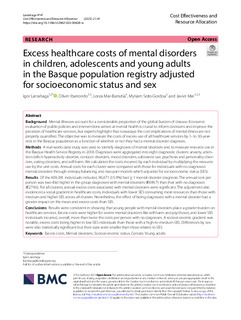Título
Excess healthcare costs of mental disorders in children, adolescents and young adults in the Basque population registry adjusted for socioeconomic status and sexAutor-a
Autor-a (de otra institución)
Otras instituciones
OsakidetzaKronikgune. Osasun Sistemen Ikerketa Institutua
Biodonostia
Versión
Version publicada
Derechos
© 2023 The AuthorsAcceso
Acceso abiertoVersión del editor
https://doi.org/10.1186/s12962-023-00428-wPublicado en
Cost Effectiveness and Resource Allocation Vol. 21. Artículo 18Editor
Springer NaturePalabras clave
Costs
Mental disorders
Socioeconomic status
Gender ... [+]
Mental disorders
Socioeconomic status
Gender ... [+]
Costs
Mental disorders
Socioeconomic status
Gender
Young adults [-]
Mental disorders
Socioeconomic status
Gender
Young adults [-]
Resumen
Background
Mental illnesses account for a considerable proportion of the global burden of disease. Economic evaluation of public policies and interventions aimed at mental health is crucial to inform ... [+]
Background
Mental illnesses account for a considerable proportion of the global burden of disease. Economic evaluation of public policies and interventions aimed at mental health is crucial to inform decisions and improve the provision of healthcare services, but experts highlight that nowadays the cost implications of mental illness are not properly quantified. The objective was to measure the costs of excess use of all healthcare services by 1- to 30-year-olds in the Basque population as a function of whether or not they had a mental disorder diagnosis.
Methods
A real-world data study was used to identify diagnoses of mental disorders and to measure resource use in the Basque Health Service Registry in 2018. Diagnoses were aggregated into eight diagnostic clusters: anxiety, attention deficit hyperactivity disorder, conduct disorders, mood disorders, substance use, psychosis and personality disorders, eating disorders, and self-harm. We calculated the costs incurred by each individual by multiplying the resource use by the unit costs. Annual costs for each cluster were compared with those for individuals with no diagnosed mental disorders through entropy balancing and two-part models which adjusted for socioeconomic status (SES).
Results
Of the 609,381 individuals included, 96,671 (15.9%) had ≥ 1 mental disorder diagnosis. The annual cost per person was two-fold higher in the group diagnosed with mental disorders (€699.7) than that with no diagnoses (€274.6). For all clusters, annual excess costs associated with mental disorders were significant. The adjustment also evidenced a social gradient in healthcare costs, individuals with lower SES consuming more resources than those with medium and higher SES across all clusters. Nonetheless, the effect of being diagnosed with a mental disorder had a greater impact on the mean and excess costs than SES.
Conclusions
Results were consistent in showing that young people with mental disorders place a greater burden on healthcare services. Excess costs were higher for severe mental disorders like self-harm and psychoses, and lower SES individuals incurred, overall, more than twice the costs per person with no diagnoses. A socioeconomic gradient was notable, excess costs being higher in low SES individuals than those with a high-to-medium SES. Differences by sex were also statistically significant but their sizes were smaller than those related to SES. [-]
Colecciones
- Artículos - Ingeniería [688]
El ítem tiene asociados los siguientes ficheros de licencia:























